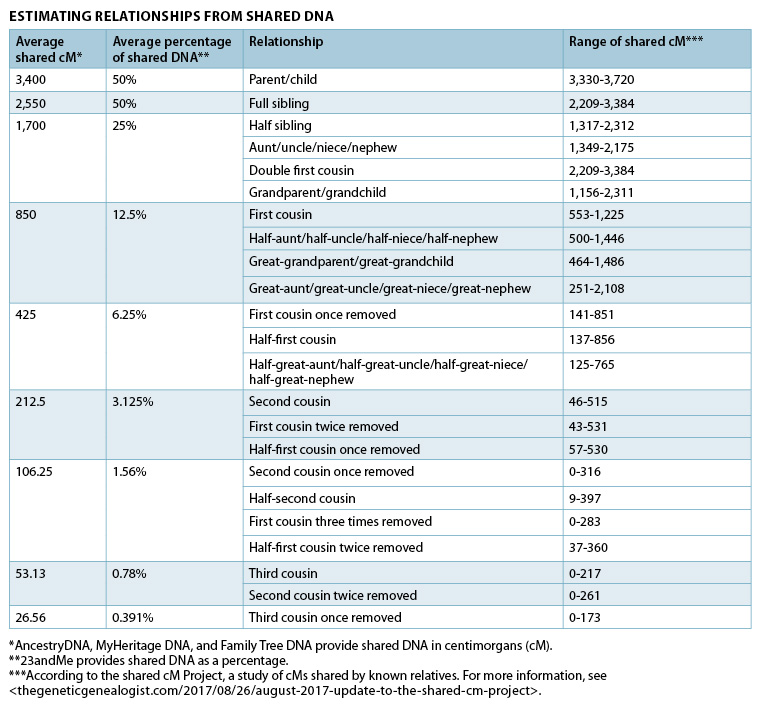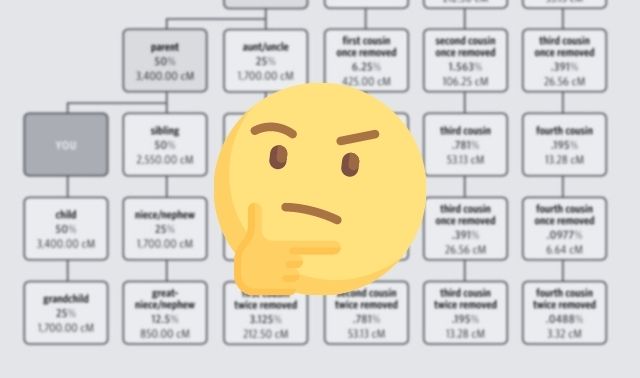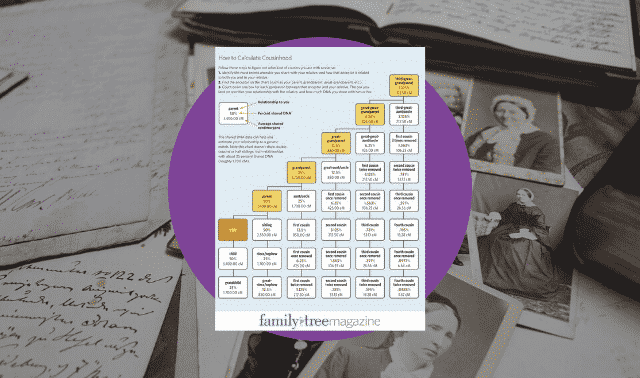Looking for your birth parents, cousins and other relatives? Curious about how to determine relationships from shared DNA? This guide can help.
Autosomal DNA testing companies report the amount of DNA you and a match share to give you an estimate of your relationship. The chart below expands on those estimates (measured in centimorgans, or cM) to help you more figure out how you and a match are related. Use this chart to learn how to use shared DNA to determine relationships with matches.
In the “Average Percentage” column below, find the number nearest to your shared cM. The Relationship column shows the likely relationship(s). Other relationships are possible, though, as shown in the “Range” column. For example, if you share 900 cM with someone, possible relationships include first cousins, half-aunt/uncle and half-niece/nephew, great-grandparent/great-grandchild, and great-aunt/uncle and great-niece/nephew.
Estimating Relationships from Shared DNA

The closer the relationship, the more useful the match will be in your genealogy search. For example, second cousins share great-grandparents. If you have a second-cousin match, find the person’s great-grandparents in his family tree. Then research that couple’s descendants—one of them may be your birth parent.
Note that a given relationship, such as first cousins, can share varying amounts of DNA because of recombination (“shuffling” that occurs at conception). You usually share about 850 cM with a first cousin, but that number could be as low as 553 or as high as 1,225 cM. Likewise, a single shared-cM value could indicate a variety of relationships. For example, 1,200 shared cM could indicate a first cousin, great-grandparent, grandparent, or great-niece. You’ll need more information to sift through these similar values.
In addition, note that different DNA testing companies have different methods of calculating and presenting amounts of shared DNA. As a result, you and a match may share different amounts of cM when comparing at different services.
Last Updated: February 2020
How to Determine Relationships with Shared DNA Matches
By Family Tree EditorsLooking for your birth parents, cousins and other relatives? Curious about how to determine relationships from shared DNA? This guide can help.
Autosomal DNA testing companies report the amount of DNA you and a match share to give you an estimate of your relationship. The chart below expands on those estimates (measured in centimorgans, or cM) to help you more figure out how you and a match are related. Use this chart to learn how to use shared DNA to determine relationships with matches.
In the “Average Percentage” column below, find the number nearest to your shared cM. The Relationship column shows the likely relationship(s). Other relationships are possible, though, as shown in the “Range” column. For example, if you share 900 cM with someone, possible relationships include first cousins, half-aunt/uncle and half-niece/nephew, great-grandparent/great-grandchild, and great-aunt/uncle and great-niece/nephew.
Estimating Relationships from Shared DNA

The closer the relationship, the more useful the match will be in your genealogy search. For example, second cousins share great-grandparents. If you have a second-cousin match, find the person’s great-grandparents in his family tree. Then research that couple’s descendants—one of them may be your birth parent.
Note that a given relationship, such as first cousins, can share varying amounts of DNA because of recombination (“shuffling” that occurs at conception). You usually share about 850 cM with a first cousin, but that number could be as low as 553 or as high as 1,225 cM. Likewise, a single shared-cM value could indicate a variety of relationships. For example, 1,200 shared cM could indicate a first cousin, great-grandparent, grandparent, or great-niece. You’ll need more information to sift through these similar values.
In addition, note that different DNA testing companies have different methods of calculating and presenting amounts of shared DNA. As a result, you and a match may share different amounts of cM when comparing at different services.
Last Updated: February 2020


No comments:
Post a Comment